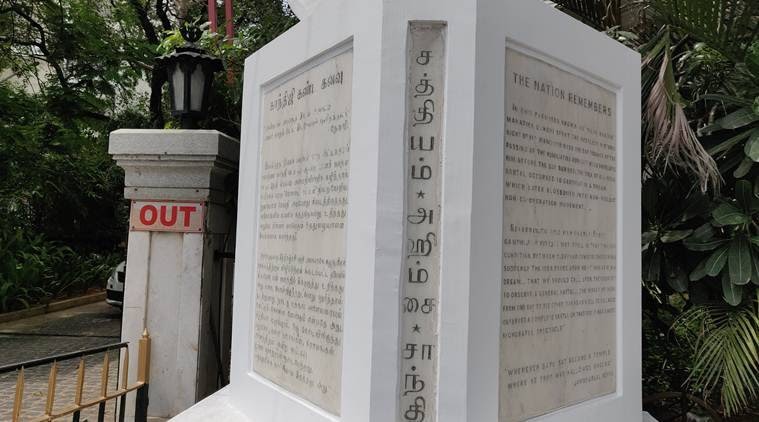As India prepares to celebrate its 75th anniversary of independence, we need to look back and honour the brave ones who fought for the freedom we have today. While the whole country strived to achieve independence from the moment of the first mutiny, there are landmarks where our fighters stood in with all the courage they could muster. From Champaran to Germany, come let’s take you on a journey to revisit the landmarks of our Indian independence struggle.
Know All the Indian Freedom Fighters!
Must Read: Significance of Independence Day
Table of contents
- Red Fort, Delhi
- Cellular Jail, Andaman & Nicobar Islands
- Jallianwala Bagh, Amritsar
- Sabarmati/Gandhi Ashram, Ahmedabad
- Aga Khan Palace, Pune
- Kashmere Gate, Delhi
- Tilak Bhavan, Chennai
- Salt Satyagraha Monument, Tiruchi
- Sankagiri Fort, Salem
- Barrackpore, West Bengal
- Jhansi, Uttar Pradesh
- Bombay, the Foundational Home of Congress
- Calcutta (Kolkata), West Bengal
- Champaran, Bihar
- Chauri Chaura, Uttar Pradesh
- Kakori, Uttar Pradesh
- Lahore, Pakistan
- San Fransisco, California
- Germany
Red Fort, Delhi

When we talk about the Indian independence struggle and the landmarks that contributed to the country’s liberation, the Red Fort is the first place that comes to mind. Since its construction by Mughal emperor Shah Jahan, the Red Fort has served as a symbol of Indian might. Built of red sandstone, this fort has resisted several attacks since the British arrived in India. The British took seized this fort and transformed it into their army headquarters after defeating the final Mughal emperor, Bahadur Shah Zafar, in 1857.
The fort was taken over by the Indian Army when India became independent. Jawaharlal Nehru, India’s first Prime Minister, raised the national flag and gave a speech at this historic site on August 15, 1947. This tradition is still alive and well, and it is well worth participating in.
Cellular Jail, Andaman & Nicobar Islands

You must have heard of Kala Pani in the historic patriotic Bollywood movies! Well, the Cellular Jail was known as Kala Pani in those days and holds significance in the Indian independence struggle. While the British had used the island as a prison since 1857, the jail itself was built between 1896 and 1906, based on Jeremy Bentham’s Panopticon design, which allowed one watchman in the centre to see all prisoners. The island is now a freedom monument, having housed numerous political prisoners and freedom fighters, including Vinayak Damodar Savarkar.
Jallianwala Bagh, Amritsar

It’s nearly difficult to describe the Indian independence struggle without mentioning the Jallianwala Bagh Massacre, 1919. It is one of the incidents that still makes every Indian’s blood boil. When tens of thousands of people gathered in Amritsar’s walled garden to peacefully protest on April 13, 1919, Brigadier-General Reginald Dyer ordered his soldiers to open fire on the crowds, killing over 1,000 men, women, and children. This terrible act alarmed the whole country and sparked a whole slew of movements, including radical revolutionary ones. The garden is now a renowned monument visited by thousands of tourists each year.
Know more about the Popular Struggles and Movements!
Sabarmati/Gandhi Ashram, Ahmedabad

In South Africa, Mahatma Gandhi established Tolstoy Farm, a self-sufficient village. In 1915, when he returned to India, he founded an ashram in Ahmedabad based on the same ideals. Gandhi thought this location, which was situated between a British jail and a crematorium, was ideal for his famous truth experiments. This ashram, which is considered a major site of Gandhian Satyagraha, saw several historical activities, including the Dandi Salt March in 1930. Sabarmati Ashram played a key role in Indian independence struggle and continues to have a significant position in the country’s history. The ashram is currently designed to preserve the memory of the Nation’s Father.
Read more about the Making of National Movement!
Aga Khan Palace, Pune

Imam Sultan Muhammad Shah Aga Khan III built this majestic mansion in 1892 as a jail for high-priority political prisoners in British India. Aga Khan Palace holds significance in India’s freedom and is one of the locations associated with the Indian independence struggle. Mahatma Gandhi, his wife Kasturba, and close friend Mahadev Desai were all secretly imprisoned here shortly after the Quit India Movement was announced in 1942. Desai and Kasturba Gandhi both died at this mansion, which still has personal belongings from each of them.
Kashmere Gate, Delhi

Kashmere Gate, located near St James Church and past the Red Fort, is the culmination of the following: a Mughal structure with British additions. Narrow Mughal-style Lahori bricks mix with larger colonial-era bricks in the mostly-exposed brick building. A plaque at the gateway says, “During the Mutiny, Indian independence warriors utilised the gate to attack Britishers by firing cannonballs,” implying that the British are no longer in charge.
Tilak Bhavan, Chennai

Tilak Bhavan, in its own capacity, contributed to the Indian independence struggle. At this location, Mahatma Gandhi spent many days in this Bhavan, the most notable of which was March 18, 1919, around the time the Rowlatt Bills were passed. Gandhi pondered how to fight it throughout the entire night. Gandhi’s idea soon blossomed into a nonviolent, non-cooperation campaign that would pave the road for the country’s eventual freedom many years later.
Salt Satyagraha Monument, Tiruchi

Salt Satyagraha Monument hold a significant role in the Indian independence struggle. At a junction leading to the Tiruchi Railway Junction, two pillars memorialise a nonviolent act of civil disobedience. On April 13, 1930, C Rajagopalachari led a group of 150 people, primarily from the Indian National Congress, on a 240-kilometre march to the seaside village of Vedaranyam, which was memorialized by the pillars. The Vedaranyam Salt March, modelled after Gandhi’s Dandi March a month before, was a rallying cry against the British Raj’s unfair tax practises. The first pillar was constructed in 1973, and the second was constructed in 1986.
Sankagiri Fort, Salem

The Vijayanagar Empire built the Sankagiri Fort in the 15th century, and it was later expanded by Hyder Ali, Tipu Sultan, and the British. J Barnabas, general secretary of the Salem Historical Society, claims it was once used as a watchtower by Kongu chieftains. There are 11 gates and five or six tiers of walls at the Fort. It served as a treasury and an armoury. The storey of Kongu chieftain Dheeran Chinnamalai, who waged wars against the East India Company is one of the Fort’s defining features. According to legend, he once caught a British army on their way to Mysore with tax money and gave it to the locals at Sankagiri Fort. In July 1805, he was hung at the Fort.
Barrackpore, West Bengal

Another renowned landmark of the Indian Independence struggle, Barrackpore is the oldest cantonment of India and is the seat of the famous rebellion of 1857. Sepoy Mangal Pandey called for the first rebellion against British rule in Barrackpore.
Jhansi, Uttar Pradesh

The inspirational story of Rani Lakshmi Bai is something all of us have read in our school life. But Lakshmi Bai’s city, Jhansi, played such a crucial role in the Indian independence struggle because that’s where the spark of Sepoy mutiny transformed into war. The war further ensued when the ‘Doctrine of Lapse’ policy refused the throne to the adopted heir of Jhansi and all this led to even more revolutions in and around Jhansi.
Bombay, the Foundational Home of Congress

Congress (now Indian National Congress) was founded in Bombay (now Mumbai) by Allan Octavian Hume. Gandhi was also believed to have arrived in Bombay first from South Africa to collect funding from the rich capitalists there. Bombay was also home to the cinematic Bollywood and did its best to portray the colonial rule of the British during that era.
Calcutta (Kolkata), West Bengal

The Indian National Association, the first nationalist organisation was founded in Calcutta. It was the centre of Indian nationalism and gave us great leaders like Subhash Chandra Bose. Many famous poets, writers and social reformers were directly or indirectly associated with Calcutta. The Swadeshi Movement finds its roots in Bengal of the British rulers, and Kolkata became the hotspot of many revolutionaries!
Champaran, Bihar

The Champaran Satyagraha was Mahatma Gandhi‘s first non-violent initiative. Indian farmers were forced to cultivate indigo rather than the food crops necessary for survival. This is where Gandhi decided to use his ideal of non-violence to rebel against British rule.
Chauri Chaura, Uttar Pradesh

Famous for the Chauri Chaura Incident, this landmark of the Indian independence struggle is where the police first killed several peaceful demonstrators. In retaliation, the angry mob set the police chowki (Police Station) on fire, killing 22 policemen. Gandhiji called off the non-cooperation movement in 1922 in the wake of this incident.
Kakori, Uttar Pradesh

This small town is famous for the Kakori Conspiracy that took place on 9th August 1925. Indian revolutionaries looted the train carrying money bags belonging to the British government treasury. This was the first case in the history of the Indian independence movement when British property was looted.
Lahore, Pakistan

Sardar Bhagat Singh, the famous martyr, was hanged in Lahore. The first time that the declaration of the Independence of India was passed on 31st December. In the Lahore session, Indian National Flag was adopted and 26th January was selected as Independence Day of India.
Check out the Color Revolutions of India!
San Fransisco, California

The Yugantar Ashram in San Francisco housed the headquarters of the Ghadar Party of expatriate Punjabis and Sikhs. The Ghadar Party fuelled the liberation movement of India from abroad.
Germany

The Berlin Committee, known as the Indian Independence Committee after 1915, was formed in Germany in 1914 during World War I by Indian students and political activists there.
Thus, we hope this blog took you on a trip down memory lane revisiting the landmarks of the Indian independence struggle. Happy Independence Day from Leverage Edu! For more such inspirational content, keep watching this space at Leverage Edu!
 One app for all your study abroad needs
One app for all your study abroad needs

















 45,000+ students realised their study abroad dream with us. Take the first step today.
45,000+ students realised their study abroad dream with us. Take the first step today.

